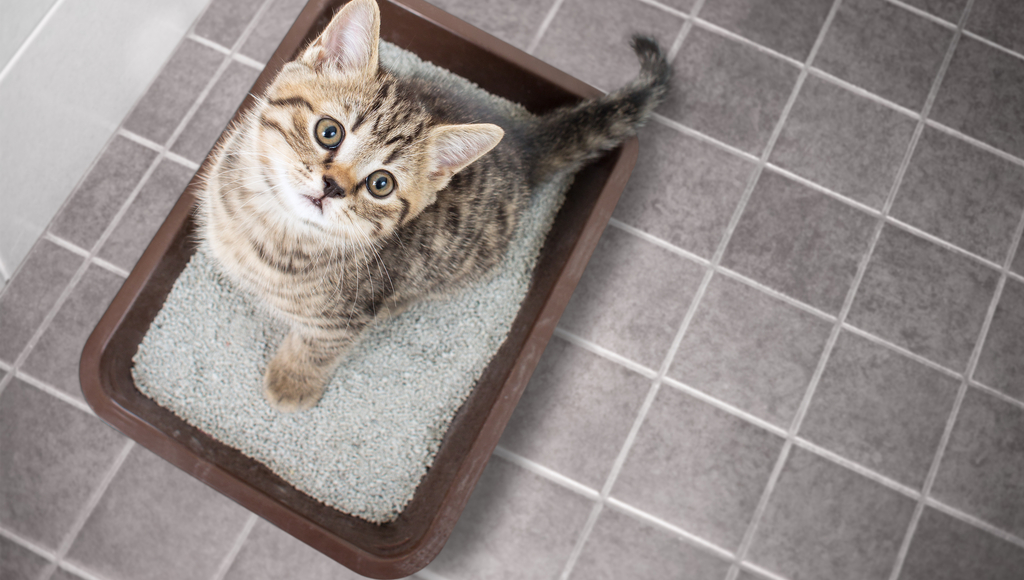Litter Box Basics - Can You Have Too Many?
Everything you need to know about litter box placement.

No matter how many cats you live with, making sure the litter box is where they eliminate is of the utmost importance. It isn't always as simple as putting the box in the laundry room, showing the cat it's there, and trusting she'll use it every time. The type of litter you use, the location of the box and its accessibility are all important factors in proper feline elimination. Nothing, however, may be more important than the number of litter boxes you have.
The Litter Box Golden Rule
The rule of thumb is to have one litter box for each cat in your home, plus an additional one So, the minimum number of litter boxes you need is x+1, where x = the number of cats you have. For instance, if you have three cats, you should have four litter boxes available. The reasoning is that some cats won't use a litter box after another cat has used it. By having one for every cat, they can each use their own.
Many cats won't use a litter box that has too much waste in it, even if the waste is her own; the extra one gives her a place to go if her primary box is dirty. Without it, she may decide your carpet is a good alternative to her dirty litter box. This is sound advice even if you have only one cat.
If your home is multi-story and your cat has access to each floor, placing a litter box on each level is a great idea. Think of how inconvenient it is for you to have to go up or down stairs when you really need to use the bathroom. It's the same for your cat. Unlike you, however, your cat doesn't feel bad about using the couch if her "bathroom" is too far.
Location, Location, Location
Litter box placement is important no matter the number of cats in your household.
Avoid placing a box near a loud appliance, like a washing machine or an air conditioning unit. The sound can cause anxiety. Items that give off heat, like a furnace or a clothes dryer, may make your cat uncomfortable while also amplifying the smell of the waste. Sound, heat, and smell can all result in your cat avoiding the litter box and using an inappropriate location to relieve herself.
Keep your cat's litter box accessible. If it's in a room with a door, use a door stop to both keep it open and prevent your cat from accidentally (or purposely?) closing herself inside the room. If you leave your cat in a particular room when you have company or when you go out, be sure she has a litter box there, even if you don't normally keep one in that room.
Avoid putting the litter box near her water and food bowls. The odor from the box could affect her eating and drinking.
Whether you have one or multiple cats, do not place litter boxes next to each other. You may find that your cat won't use either box if one is dirty. Your cat will see the side-by-side boxes as one large litter box and avoid it until it's clean.
Find the best location for your cat's litter box by observing your cat's habits. Where does she like to spend a lot of her time? Putting the box nearby that area is ideal, as long as it isn't the middle of your living room.
Privacy, Please
If you do have multiple cats, it's best to put their litter boxes a good distance away from each other. Some cats are territorial about their boxes and could guard the area, preventing your other cats from using their own boxes if they're close together. Even if your cats get along otherwise, one or more may be inclined to bully another when it comes to using their bathroom. Sufficient distance between each box means they can't cover them all at once!
Distance between your cats' litter boxes also provides privacy for them while eliminating. Unlike dogs who are pack animals, cats like to be alone sometimes, and litter boxes can serve as a welcome place to escape.
Size Does Matter
Even if you're diligent about cleaning your cat's litter box each day, larger boxes are still preferable for most cats. The more surface area for your cat to walk around on, the more likely she is to consistently use it.
Covered litter boxes are appealing to humans because it hides the mess inside and cuts down on the amount of litter dust that is released into the room. Some cats may even like the extra privacy. If you have a larger cat, though, she may find it difficult to maneuver within the box.
According to the ASPCA, one to two inches of cat litter is the preferred amount. Cats react better to shallow layers of litter, so avoid overfilling the box. Use a box that's easy to enter. Your cat shouldn't have to jump to get into her litter box. The ASPCA suggests a shallow plastic storage bin if you want a low-cost litter box alternative.
If you have a cat who still has problems using her litter box, despite having at least two options in the home, you should call your veterinarian. Several medical conditions can cause inappropriate elimination in cats. When you've ruled out issues such as location and accessibility, an aversion to the box itself or the type of litter you're using, and bullying from another cat in the home, it's time to confirm there isn't an underlying physical problem.
Ready to start saving money on pet wellness care?
Then take a look at Mint Wellness, the pet wellness plan that provides fast reimbursement on routine pet care. Save on vaccinations, wellness exams, preventatives, dental, and more!
Learn More


